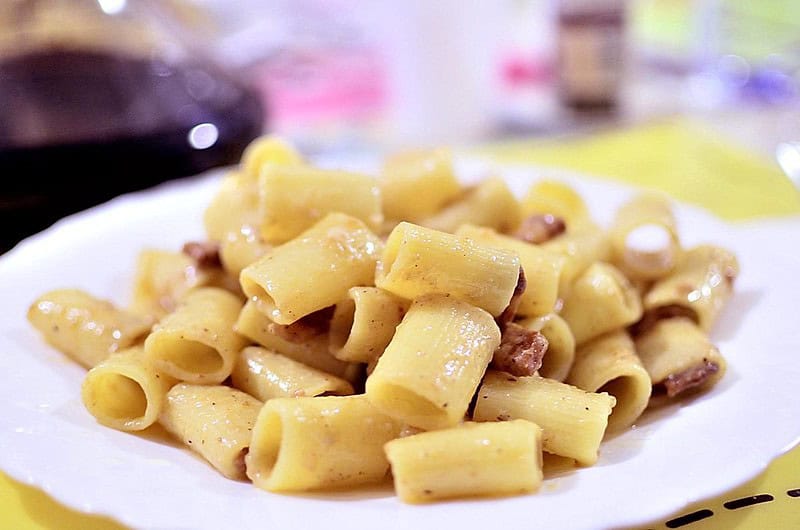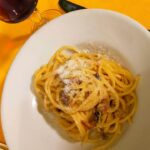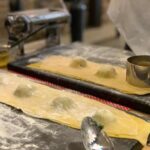Best Roman Pasta Dishes
4 classic Roman pasta dishes: Spaghetti alla Carbonara, Cacio e Pepe, Bucatini all’Amatriciana, Pasta alla Gricia. These dishes have formed the pillars of Italian family meals for centuries. They are quick to make and use cooking methods that are common across all dishes.
The beauty of these traditional Roman pasta dishes lie in the combination of a few quality fresh ingredients combined with a sauce made with the starchy pasta water. The region of Lazio is famed for the origins of these four dishes. The Lazio is rich with beautiful beaches, glorious mountains and world famous archaeological gems. Any foodie visiting its capital city of Rome, should also explore the wider region to discover its true gastronomical heritage.
The Best Roman Pasta Dishes to eat
Spaghetti alla Carbonara

Carbonara is probably one the most famous of all Roman pasta dishes. It’s widely accepted that earlier versions of carbonara have been cooked in Italy since the 1700’s. However, it was during the post-World War II era that the modern dish was more widely cooked and recipes appeared in food writings in the late 1940’s and early 1950’s.
The mighty carbonara is famous around the world, but variants of this dish unfortunately do exist. The use of cream (single, double or any other kind whatsoever) is strictly a no. Garlic, onions, basil, herbs, butter and even olive oil do not feature in a traditional Roman carbonara.
Spaghetti is traditionally used, but you will see other pasta’s being used even across Rome.
How to make Carbonara?
Core ingredients: Pasta + Guanciale + Eggs + Pecorino Romana + Black Pepper
5 simple ingredients are needed: spaghetti, eggs (use only the yolk), guanciale (cured pig cheek), freshly grated Pecorino Romano (salty hard Italian cheese) and black pepper.
Separate the egg yolks and whisk in the grated Pecorino Romano and a generous helping of black pepper. Remove the outer cured skin from the guanciale and dice into small chunks. If you are not able to get guanciale, you may use pancetta. Add the meat
to a pan and gently fry, no need to add oil as the meat will cook beautifully in its own fat. This is where the best flavour comes from.
Boil your spaghetti al dente and when ready, simply transfer the pasta with a slotted spoon directly into the pan with the meat. Add a small ladle of the starchy pasta water, stir and take off the heat. Pour in the egg and cheese mixture and gently stir – but not too vigorously to prevent the eggs from scrambling. You can add the pan back onto a low heat for a minute while stirring a couple more times. Serve topped with a little more grated Pecorino Romano and cracked black pepper.
Cacio e Pepe

This Roman “cheese and pepper” dish is a creamy pasta meal with no less and no more than 3 ingredients:
Pasta – ideally tonnarelli or spaghetti Pecorino Romano
Black pepper
Ok, technically there are 4 ingredients if you count the water to boil the pasta. But that’s it. Essentially the simple base ingredients of a carbonara without the meat or eggs. The lifespan of the raw ingredients and the ease of transportation enabled nomadic shepherds to prepare this meal easily, even as far back at the Roman times according to some.
Pecorino Romano (made from sheep’s milk) is traditionally used for this dish with its slightly stronger flavour, as opposed to Parmigiano Reggiano (made from cow’s milk). Both are hard cheeses with a salty taste, but Pecorino Romano has been around since ancient times and is an authentic Roman ingredient.
How to make Cacio e Pepe?
Core ingredients: Pasta + Pecorino Romana + Black Pepper
As simple as the ingredients are, the success of the dish is dependent upon the cooks attention to timing and proportion of pasta water used in the final stage.
While you bring to the water to boil in a large pot, grind fresh black peppercorns and grate the Pecorino Romana and set aside. Once you add the spaghetti to the boiling
water, ensure it’s cooked for only half of the suggested time. The rest of the cooking will take place in the next stage.
In another pan, lightly toast the freshly cracked pepper for a minute then stir in a small amount of the pasta water. With a slotted spoon or tongs, add the pasta to the pan with the pepper along with a ladle of pasta water. Keep stirring so that the starch releases into the pan mixing with the pepper. With practice you will get the hang of how much water to add to release the starch, while leaving a small amount of liquid in the pan.
Add the grated Pecorino Romana to the pan and mix well, you should see a creamy texture develop as the cheese melts in. Take off the heat and stir a few more times to dissolve any large chunks.
Serve immediately topped with a little more pepper and cheese.
Bucatini all’Amatriciana

Named after its northern Lazio town of origin, Amatrice, this dish incorporates the humble tomato and transforms simple ingredients into a delicious filling feast. Amatrice, the self-proclaimed ‘City of Spaghetti’ would of course only use spaghetti in this dish. However, within Rome’s restaurants and trattorias, bucatini is more commonly used. Bucatini pasta is very similar to spaghetti, but its form is thicker and hollow inside.
A white and red version of pasta all’amatriciana exists within Amarice, one with tomatoes and one without. While within Rome, the addition of onion, garlic and even chilli is now so popular, you’ll find few places serving bucatini all’amatriciana without some of these ingredients.
The ingredients used for a pasta all’amatriciana dish can be quite a serious topic among Italian foodies – everyone has their style, their take on the ‘tradition’ and opinion on the best method. For the purposes of this article we have taken a typical Roman approach.
How to make Bucatini all’Amatriciana?
Core ingredients: Pasta + Guanciale + Pecorino Romana + Tomatoes
Boil water in a pot and just before adding the bucatini, salt the water. Cover and leave to simmer. In another pan gently soften the diced onion with a little olive oil. Then add the diced guanciale (or pancetta if unavailable) and fry on a low heat to allow the natural fat
to release. Fry until the meat is crispy and the solid fat is transparent, but be careful not to burn and taint the flavour of the oil. Remove the meat and onions and set aside.
Turn up the heat a little, add a splash of white wine and then reduce to allow the alcohol to evaporate. This will help to eliminate any overt fat or burnt undertones. Next add a small ladle of the pasta water and stir well. Now time to add the tomatoes.
Where possible use San Marzano tomatoes which are famed for their sweeter taste and flesher inside as they contain fewer seeds. If using tinned tomatoes mash down in a bowl before adding to the pan with a pinch of salt.
To add chili or not to add chili – that is the million dollar question????
Some cooks add a whole fresh chili or chili flakes at the initial frying stage, while others add a chili at the tomato stage, and then remove before serving. On the stage of food diplomacy, we will leave this entirely up to your taste.
Going back to the bucatini, this should be ready al dente. Remove the pasta, add directly to the tomato sauce and mix well along with the cooked guanciale. Add a little more of the pasta water and a generous amount of freshly grated Pecorino Romana. Stir well, serve and enjoy.
Pasta alla Gricia

Now this dish may seem a bit repetitive in similarities to the other three Roman pasta dishes. And that’s because it is! Essentially, pasta all gricia is the carbonara without the egg, or the cacio e pepe but with pork, or the pasta all’amatriciana but without the tomatoes.
Pasta alla gricia is considered the predecessor to amatriciana. Shepherds would make this dish long before the readily availability of tomatoes and again the core ingredients lasted well for a long time.
How to make Pasta alla Gricia?
Core ingredients: Pasta + Guanciale + Pecorino Romana + Black Pepper
Like the other dishes, this is a very simple, quick and easy dish to prepare, given you have the best quality ingredients and you get your timing right. Never commit the
cardinal sin of overcooking your pasta, add just the right amount of pasta water to make the sauce and don’t burn the precious guanciale.
The pasta of choice for this dish is usually spaghetti or rigatoni – a short, fat, tube like pasta shape. Bring the pasta to the boil with salt. While the pasta is boiling, prepare and cube the guanciale and fry in its own fat juice on a low to medium heat.
Common through all the guanciale based dishes, the fat render from the cured pork cheek is what gives each dish its unique flavour. A rich pork flavour that is simply not the same if using alternatives such as bacon.
When the guanciale is perfectly crispy, lower the heat and add a small ladle of the starchy pasta water and stir to mix all the flavours of the pan. Next add the pasta of choice (al dente of course) directly to the pan, and toss well to coat all the pasta.
Finally, add the grated Pecorino Romana and black pepper along with another small ladle of pasta water. It is here that the perfect creamy consistency should form. As with the other dishes, take the pan off the heat and stir a few more times to dissolve any large chunks.
Buon Appetito.



